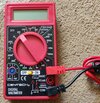I am trying to hardware the front and the rear dashcam. Until now, I would just plug into the USB ports but I am considering installing seat warmers for winter days. So my options are either hardwire either of them or install a 12V outlet strip.
I don't know yet which way I should go, but I would like to understand hardwire basics. Let me be super honest, I know absolutely nothing about electrical, so please feed me from the basics. I have watched a few Youtube tutorials and tried to replicate them but ended up blowing the fuse.
My fusebox (2006 Sentra) looks like the below and I will be tapping into the accessory fuse (marked). Mine is 15A, not 10A.

I don't know which side is live, the bottom one or the top one. I tried to figure out using a multimeter but when I touched either side, it flew tiny sparkles, blew the fuse, and the multimeter wire turned HOT. The negative was connected to the door bolt.
This is how I set the multimeter. Clearly, something is wrong.

This is the fuse tap, I will try to use.

Can anyone please guide me on how I should orient the fuse tap? Plus, how do I make sure that the bolt I am tapping into is indeed ground?
I do not want to blow the dashcam or the 12V accessory strip.
Appreciate all the guidance. Thanks in advance.
I don't know yet which way I should go, but I would like to understand hardwire basics. Let me be super honest, I know absolutely nothing about electrical, so please feed me from the basics. I have watched a few Youtube tutorials and tried to replicate them but ended up blowing the fuse.
My fusebox (2006 Sentra) looks like the below and I will be tapping into the accessory fuse (marked). Mine is 15A, not 10A.

I don't know which side is live, the bottom one or the top one. I tried to figure out using a multimeter but when I touched either side, it flew tiny sparkles, blew the fuse, and the multimeter wire turned HOT. The negative was connected to the door bolt.
This is how I set the multimeter. Clearly, something is wrong.

This is the fuse tap, I will try to use.

Can anyone please guide me on how I should orient the fuse tap? Plus, how do I make sure that the bolt I am tapping into is indeed ground?
I do not want to blow the dashcam or the 12V accessory strip.
Appreciate all the guidance. Thanks in advance.
